
Vegetable Pollinator Stewardship Guide
DOWNLOADApril 16, 2021 - Ana Heck, Ron Goldy, Benjamin Phillips and Benjamin Werling
Last updated: April 16, 2021
Spanish version: Guía del Cuidado de Polinizadores de Hortalizas
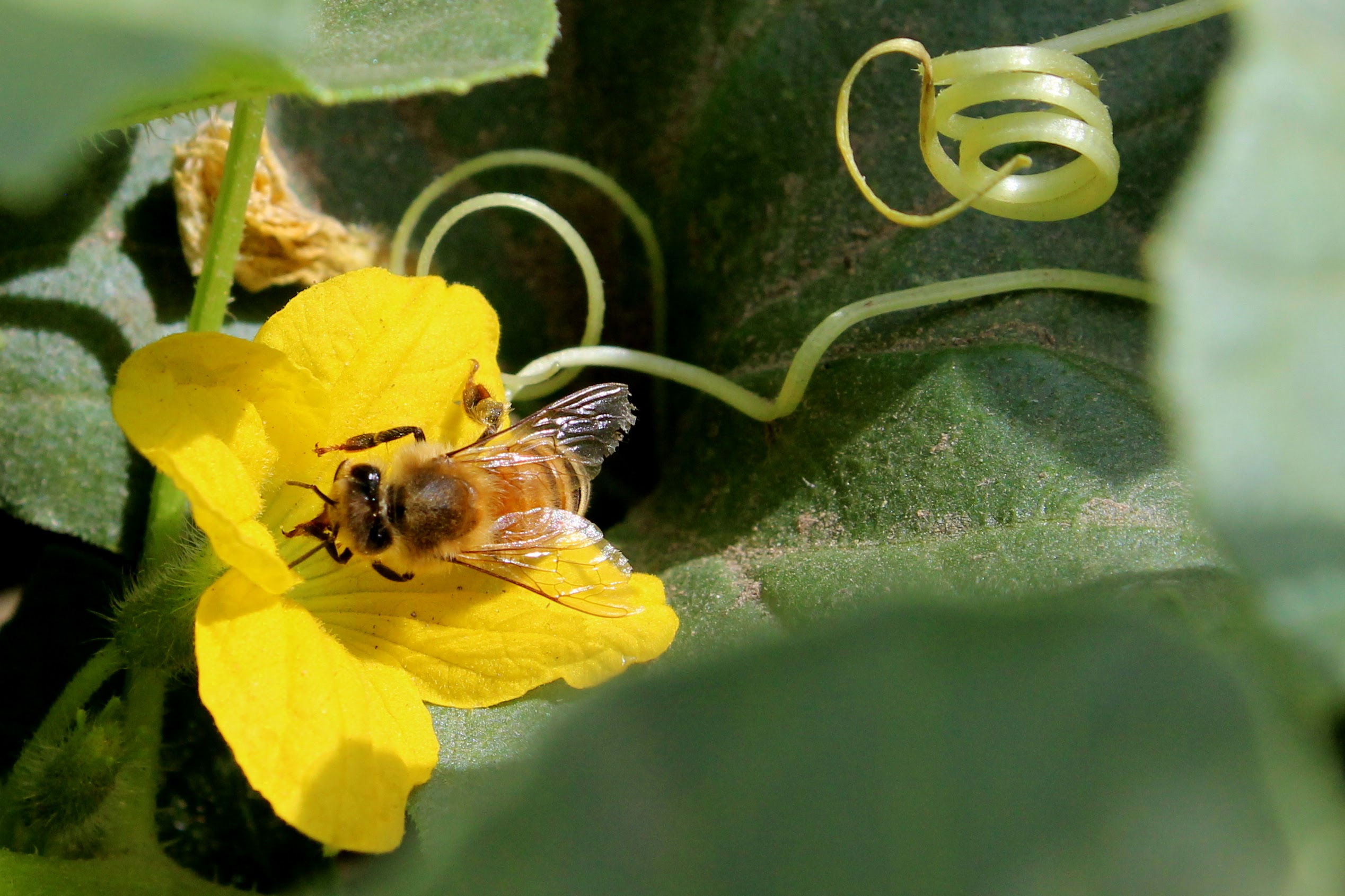
Key recommendations for protecting your investment in pollination
- Use integrated pest management strategies to reduce pesticide exposure to bees
- Minimize the use of insecticides and fungicides during bloom
- Support bee health by establishing bee foraging plantings on your farm
- Learn about bees and share what you know
- Communicate with your beekeeper about bee health and pesticides
In this guide
Benefits of Adopting a Pollinator Stewardship Plan
Help Bees by Reducing Pesticide Exposure
Which Pesticides are Safe for Bees?
Communication with Your Beekeeper
Other Ways to Help Bees
Benefits of adopting a pollinator stewardship plan
Bees face many issues that affect their health, including parasites, diseases, lack of forage, and pesticide exposure. Bees often face these challenges at the same time, which can make it difficult for them to thrive. Growers can play a role in supporting pollinator health on their farms. Many growers understand that bees are facing health issues and are willing to help.
This Pollinator Stewardship Guide can help vegetable growers support pollinators on their farms and demonstrate the steps they are taking to help. Growers are in a unique position to help pollinators because of the amount of land they manage. They can make a big difference by reducing or mitigating the harmful effects of pesticides on pollinators and by increasing flowering plants on their land.
Bees provide pollination to many fruit and vegetable crops. While the recommendations in this guide will apply to many different types of vegetables, special consideration is given to fruiting vegetables that need pollination from bees: cucumbers, gourds, melons, pumpkin, and squash. These crops depend on pollination to produce fruit. Bees collect pollen and nectar from blossoms and move pollen between the male and female flowers as they visit. Pollination is a mutually beneficial relationship where bees gather nectar or pollen and the blossoms get pollinated. Special consideration is also given to vegetables that don’t need bees for pollination but have attractive pollen to bees: asparagus, potatoes, and sweet corn. Growers should be aware of bees foraging on these crops when they consider applying pesticides during bloom.
While many different species of bees may provide pollination services to vegetable crops, this guide focuses on managed pollinators, namely honey bees and sometimes bumble bees brought in for pollination. Using this guide, vegetable growers can devise a plan to support bee health and ease the stress bees face while pollinating. Other farming industries that depend on pollination are also making recommendations to support bee health. For example, the Almond Board of California released Honey Bee Best Management Practices for California Almonds, which provides a more comprehensive view of this topic.
Help bees by reducing pesticide exposure
Vegetable growers may consider including the following actions to develop their own farm-specific pollinator stewardship plan:
Use pest models
Growers can use degree day models through Michigan State University Enviorweather. Models exist for asparagus miner, cucurbit downy mildew, European corn borer, potato leafhopper, seedcorn maggot, soybean aphid, and squash vine borer. These models can help guide growers to determine when to scout for pests. Examples of models include the European corn borer model for peppers and sweet corn, the squash vine borer model, and the cucurbit downy mildew model from the Pest Information Platform for Extension & Education (ipmPIPE).
Scout for pests
Growers may be able to skip or delay pesticide applications for pests by scouting, consulting thresholds, and considering the risk in each field. Vine crop growers can scout for cucumber beetle adults; squash bug eggs, nymphs, and adults; and squash vine borer eggs, larvae, and adults as part of their integrated pest management (IPM) strategies. Sweet corn producers can scout for the eggs and larvae of cutworm, corn borer, and earworm to better time control applications.
Trap pests
Traps can be used to monitor some pests to minimize pesticide use while maximizing pesticide effectiveness. Some growers have European corn borer, corn earworm, and western bean cutworm traps to help monitor adult activity and to time spray applications in sweet corn. For squash vine borer, traps can be helpful when combined with scouting. Traps may prevent unneeded pesticide applications, which can be beneficial to both pollinators and a farm’s bottom line.
Select pest and disease-resistant varieties
Growers can also consider selecting varieties of vegetables that are resistant to insect and disease pests. For example, Attribute II and Attribute Plus sweet corn varieties are genetically engineered to carry the Cry1Ab and Vip3A proteins which are effective against all the main caterpillar pests. Transgenic squash varieties that are marketed with virus resistance are Conqueror III, Destiny III, Justice III, Prelude II, SV0914YG, and XPT 1832 III.
There are some varieties of squash and pumpkins that appear to be more attractive to cucumber beetles on some farms, and this acquired knowledge can be used to arrange plantings such that those varieties can serve as a trap crop to focus sprays on a smaller area.
There are many different disease resistant vegetable varieties. Using these varieties can reduce the need for fungicides, which can help to avoid synergistic pesticide effects between insecticides with fungicides. Cornell University maintains a list of disease resistant vegetable varieties.
Spray when bees aren’t flying (at night or during cool weather)
To avoid direct pesticide exposure to bees, growers should avoid applying pesticides when bees are flying. Honey bees typically do not fly much after sunset or when temperatures are below 50°F, but bumble bees and other native bees can fly when it’s cooler. Spraying pesticides at night may reduce pesticide exposure to bees.
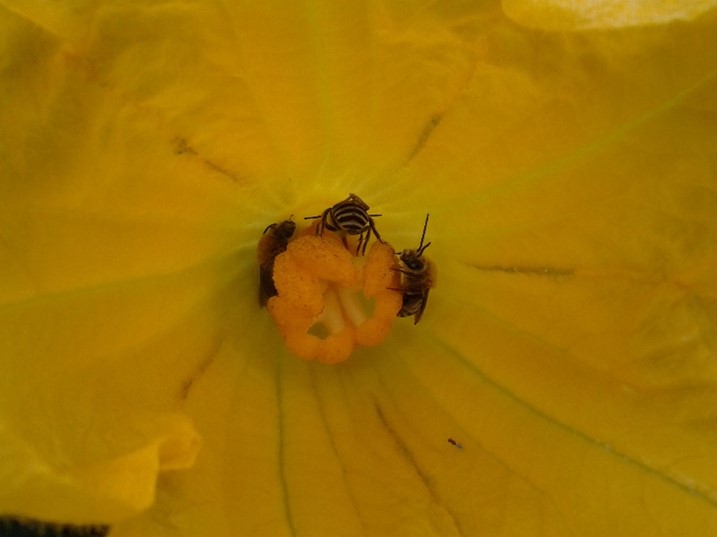
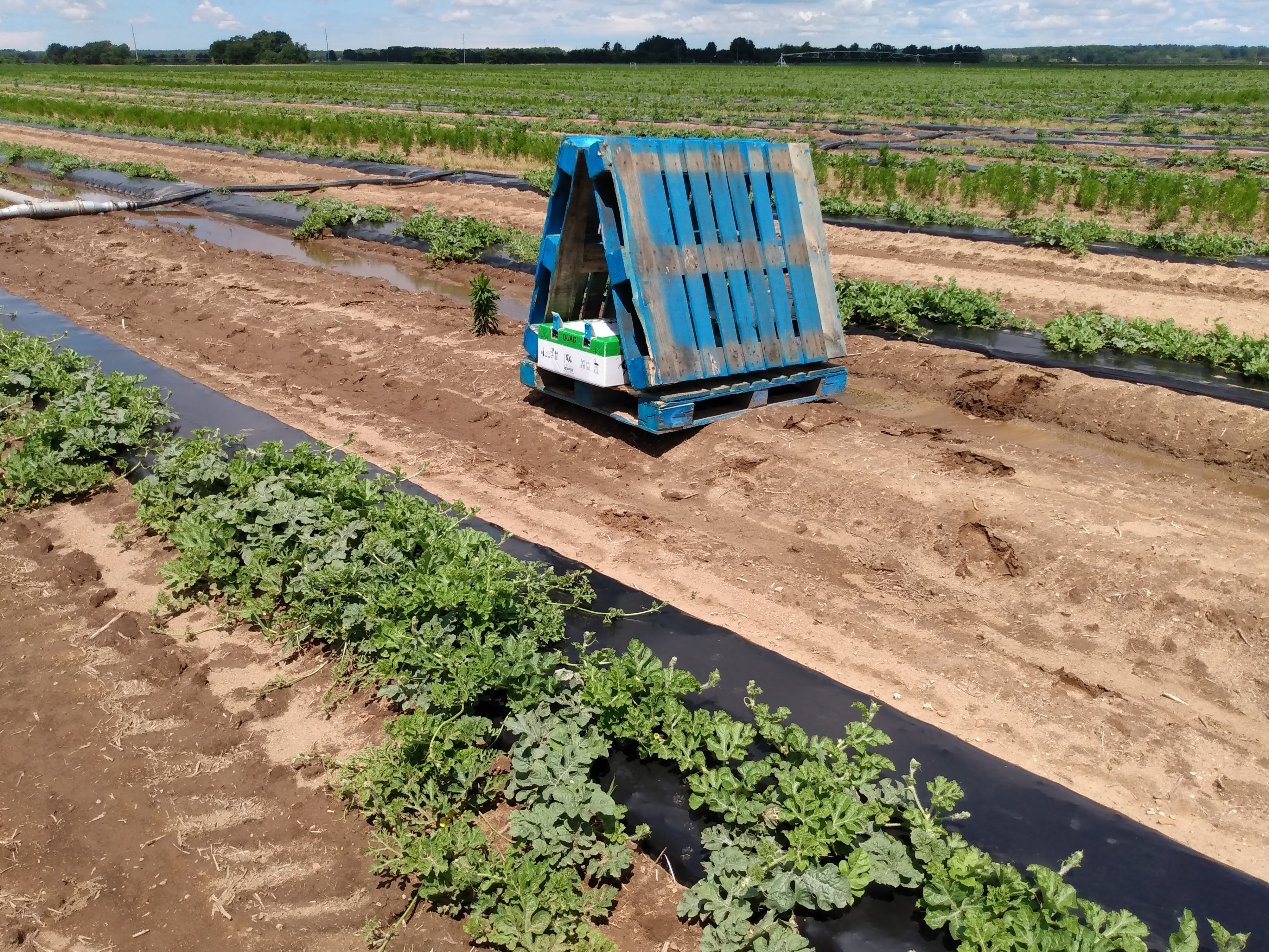
Spray when wind speed is low
Pesticides applied at windy times will drift from the target crop to flowering weeds and ditches where bees are foraging or nesting. Growers can reduce direct pesticide exposure to bees by spraying only when wind speeds are low.
Mow flowering weeds that may be exposed to pesticide drift
Many weeds, such as dandelions, clover, and milkweed, are very attractive to bees. Although flowering weeds may provide additional forage for bees, they can become a hazard if pesticides drift onto them. Prior to pesticide application, vegetable growers should consider mowing flowering weeds in their rows and field margins if the weeds risk being exposed to pesticides.
Avoid tank mixing
There are clear economic benefits to mixing pesticides in the tank, but the effects of tank mixes on bees are unpredictable and potentially harmful. Some combinations are much more toxic to bees when applied together than when applied individually. While reducing tank mixes can be costly and require more time, vegetable growers should try to reduce tank mixes, especially during bloom, to avoid negative effects on bees.
Some mixes of insecticides and fungicides have been identified as being more toxic to bees, but the effects of many tank mixes and pesticide combinations on bees have not been tested. See the section on synergistic effects between fungicides and insecticides below for examples of known mixtures that may harm bees.
Avoid using adjuvants and surfactants
Some adjuvants and surfactants make pesticides more toxic to bees because they make it easier for pesticides to penetrate a bee’s outer cuticle. However, the effects of most adjuvants and surfactants on bees have not been studied. It is suggested that the use of adjuvants and surfactants be limited to instances where they are recommended on a pesticide’s label.
Apply pesticides with accuracy and precision
Always follow a pesticide’s label instructions. Information related to bees may appear in the sections on pollinators, environmental hazards, and/or directions of use. Growers should also make sure that their sprayers are calibrated so that the pesticide is applied correctly. Most growers calibrate their machines since there is a cost incentive to targeted applications and because calibration records are important for audits.
Drop nozzle technology is one way to direct sprays more directly to a target position on plants. For sweet corn during silking, drop nozzles can be used to direct sprays directly on the silks where corn earworm eggs are laid, and avoiding the tassels where bees tend to forage for pollen.
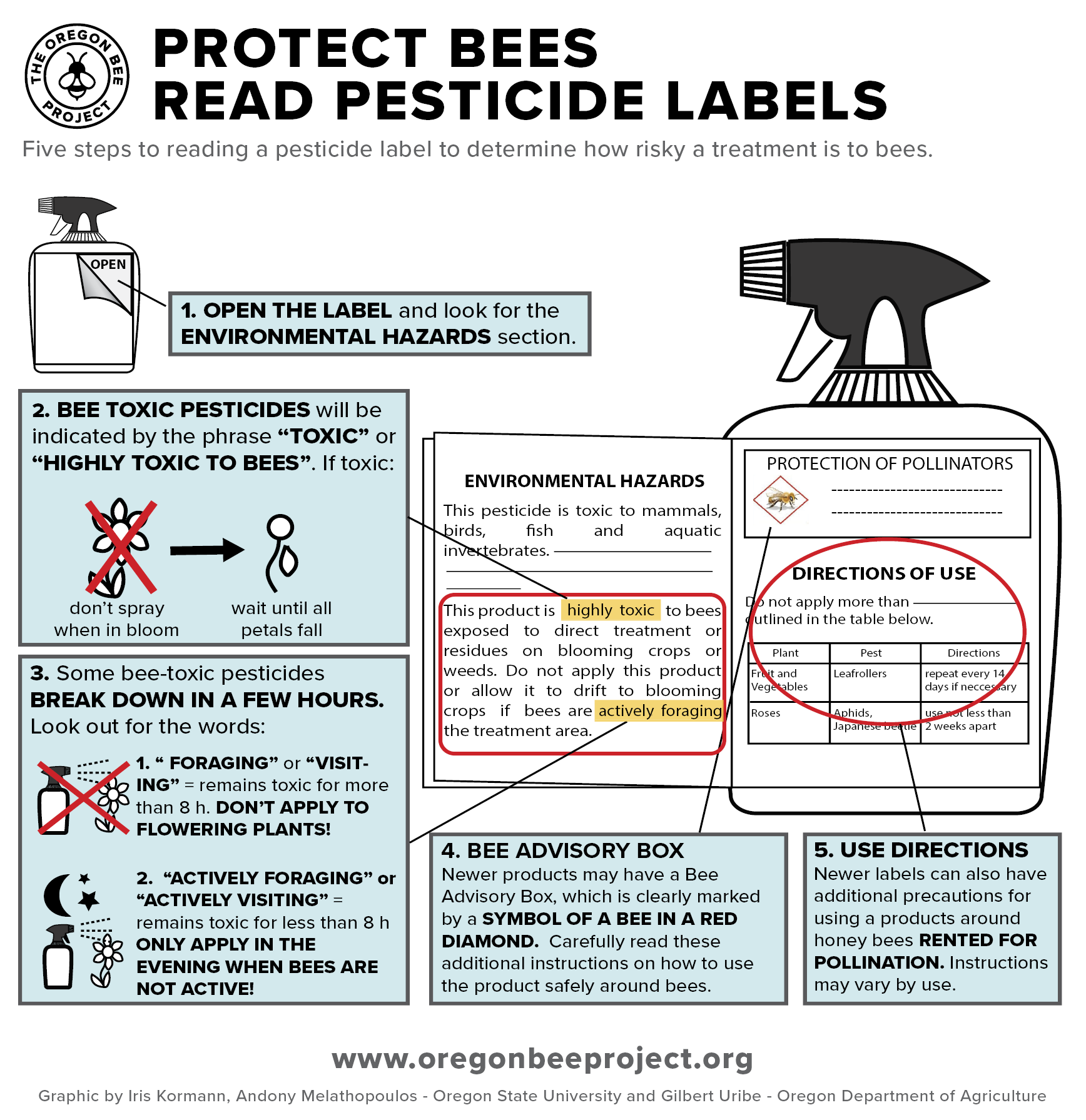
Which pesticides are safe for bees?
Many growers are concerned about pollinator health and ask which pesticides are safe for bees. While growers are required by law to not spray the most toxic insecticides when bees are foraging, even those considered ‘more safe’ can have negative effects on bee growth, development, behavior, and nutrition that can hurt honey bee colony survival or size. These sublethal effects can reduce their pollination strength and limit the beekeeper’s business.
We know which pesticides are highly toxic to adult honey bees, and their use is restricted during bloom. However, for most pesticides we don’t know enough about their effects to claim that they are “safe” for bees. Many pesticides are only tested on adult honey bees. These tests do not tell us how developing honey bee brood or other bee species, such as bumble bees, may be affected by the pesticide. Some pesticides that do not kill adult honey bees in the field may be toxic to developing honey bee larvae and pupae or to other bee species. For example, insect growth regulators can harm and kill developing bees.
Pesticides that aren’t highly toxic to adult honey bees may still be harmful. Most pesticides aren’t evaluated for sublethal effects, which may lead to reduced lifespan or a lower immune response making it harder for bees to recover from infection. Sublethal effects on individual honey bees can cause ripple effects through the hive, leading to colony decline and eventual colony death.
Since most effects of pesticides are unknown, growers should be cautious when applying pesticides, and should follow the pesticide label for every application.
Bee Precaution Pesticide Ratings
Bee precaution ratings from University of California Agriculture & Natural Resources Statewide Integrated Pest Management Bee Program present up-to-date information about the effects of specific pesticides on bees. The site ranks pesticides based on studies on each of the pesticides. It should be noted that some pesticides have been studied more than others and that some effects may be unknown.
Growers may also consult Vegetable pesticide series: Should I use it during bloom? A pollinator protection guide for vegetable growers by Ben Phillips and Marissa Schuh of Michigan State University Extension (2018).
Insecticides
Many routes of insecticide exposure:
There are many ways bees may encounter insecticides. For example, the nectar, pollen, or water that foraging honey bees gather and bring back to the colony may be contaminated with insecticides. Growing larvae within the hive are then exposed to insecticides when fed nectar and pollen during development. Many detrimental compounds can accumulate in the colony, and the resulting chronic exposure to insecticides can lead to ongoing effects and contribute to a colony’s decline.
Insecticide sprayed on blooms:
Since bees visit many varieties of flowers in bloom, insecticides sprayed on open blooms can increase bee exposure and increase bee poisoning. For example, growers may find infestations of striped cucumber beetles during bloom that need to be managed. Growers should do what they can to manage insect pests before and after bloom to avoid using insecticides during bloom when foraging bees will be visiting flowers. Some plants are more susceptible to bacterial wilt when they are small, so a well-timed spray prior to bloom can be helpful. It is recognized that this timing may be difficult with cucurbit crops due to their extended bloom period. In this case, growers should do their best to limit bee exposure by spraying at night when bees are less active.
Treated seeds:
Treated seeds, also known as encrusted seeds, are covered with a systemic pesticide, and some are covered with insecticides harmful to bees. When a seed is treated with a systemic pesticide, the pesticide can later be found in the nectar and pollen of the plant, although the amount detected may vary based on crop. Future research may help identify if certain crops do not need seed treatments and how to simultaneously protect crops and pollinators.
Fungicides
Since fungicides target fungus, it can seem counterintuitive that they would affect bee health. Nevertheless, fungicides can be quite harmful to bees. Many pesticides bind to pollen, which is important to the development of young honey bee larvae and for the nutrition of young worker bees. Fungicides have been shown to cause decreased larval survival and abnormal development in honey bees, which can lead to decreased colony population. They can also have detrimental effects on honey bee memory, learning, and behavior. Effects of sublethal pesticide exposure can be difficult to detect since it can be weeks or months before a change to colony size is noticeable.
Fungicides in the Fungicide Resistance Action Committee (FRAC 3) group are known to increase toxicity to bees. These fungicides are more often premixed with another fungicide with a different mode of action to manage disease resistance. There are many trade names, but FRAC 3 ingredients are easy to identify because they end in “azole”, including difenoconazole, metconazole, propiconazole, prothioconazole tebuconazole, and thiabendazole.
Examples of fungicides in the FRAC 3 group, which is known to increase toxicity to bees*:
|
Active Ingredient(s) |
Trade Name(s) |
|
difenoconazole, azoxystrobin |
Quadris Top |
|
difenoconazole, benzovindiflupyr |
Aprovia Top |
|
difenoconazole, cyprodinil |
Inspire Super |
|
difenoconazole, mandipropamid |
Revus Top |
|
metconazole, pyraclostrobin |
Headline AMP |
|
propiconazole |
Propimax EC, Tilt |
|
propiconazole, trifloxystrobin |
Stratego |
|
prothioconazole |
Proline 480SC |
|
tebuconazole |
Folicur 3.6F, Monsoon, Onset 3.6L, Toledo 3.6F |
|
tebuconazole, azoxystrobin |
Custodia |
|
tebuconazole, azoxystrobin, mancozeb |
Dexter Xcel |
|
tebuconazole, chlorothalonil |
Muscle ADV |
|
tebuconazole, fluopyram |
Luna Experience |
|
tebuconazole, potassium phosphite |
Viathon |
|
tebuconazole, sulfur |
Unicorn DF |
|
thiabendazole |
Mertect |
*Fungicides in other FRAC groups may also be harmful to bees. Just because a fungicide is not in the FRAC 3 group does not necessarily mean that it is safe for bees.
Synergistic effects between fungicides and insecticides:[i]
Some fungicides become much more harmful to pollinators when they are applied in combination with insecticides. For more information, please consult Vegetable pesticide series: Should I use it during bloom? A pollinator protection guide for vegetable growers by Ben Phillips and Marissa Schuh of Michigan State University Extension (2018). Other combinations not listed here may also be harmful to bees.
Mode of Action codes for insecticides from the Insecticide Resistance Action Committee (IRAC) and fungicides from the Fungicide Resistance Action Committee (FRAC) can serve as guides to whether a potential synergism could occur.
Examples of insecticides that can cause synergistic effects harmful to bees when mixed with FRAC 3 fungicides:
- IRAC 3A: pyrethroid insecticides such as Asana, Brigade, Hero, Mustang Maxx, Pounce and Up-Cyde
- IRAC 4A: neonicotinoid insecticides such as Actara, Admire Pro, Assail and Scorpion
- Flupyradifurone (IRAC 4D) insecticides such as Sivanto
- Novaluron (IRAC 15) insecticides such as Rimon
Insecticides that can cause synergistic effects harmful to bees when mixed with FRAC M5 chlorothalonil fungicides such as Bravo or Echo:
- IRAC 3A: pyrethroid insecticides such as Asana, Brigade, Hero, Mustang Maxx, Pounce and Up-Cyde
Research shows that honey bees may entomb cells of pollen containing the fungicide chlorothalonil [ii] by capping the cell with propolis (resins collected from plants) and beeswax, a behavior that some people believe may indicate that the bees detect that the pollen is contaminated.
Insecticides that can cause synergistic effects harmful to bees when combined with premixed FRAC 7 and FRAC 11 fungicides such as Elatus (azoxystrobin + benzovindiflupyr), Luna Sensation (fluopyram + trifloxystrobin), Merivon and Priaxor (both are a mix of fluxapyroxad + pyraclostrobin), and Pristine (boscalid + pyraclostrobin)
- IRAC 1 B: chlorpyrifos insecticides, such as Lorsban, Nufos, and other generics
While growers may depend on fungicides to protect their crop, they can try to reduce exposure to bees by avoiding application to blooms, reducing drift, and applying fungicides at night when bees are not flying.
Communication with your beekeeper
Finding honey bees for pollination
Honey bees from commercial beekeepers:
Large-scale, commercial beekeeping operations generally manage over 500 colonies and are migratory in nature. These operations move their colonies around the U.S. for crop pollination, honey production, and wintering, and they are accustomed to delivering and removing palletized hives in accordance with bloom timing. Many growers have longstanding relationships with commercial beekeepers, and their pollination agreements are verbal or through written contracts. When looking to rent colonies for pollination, growers might consider asking other growers in their region which beekeepers provide honey bees for pollination.
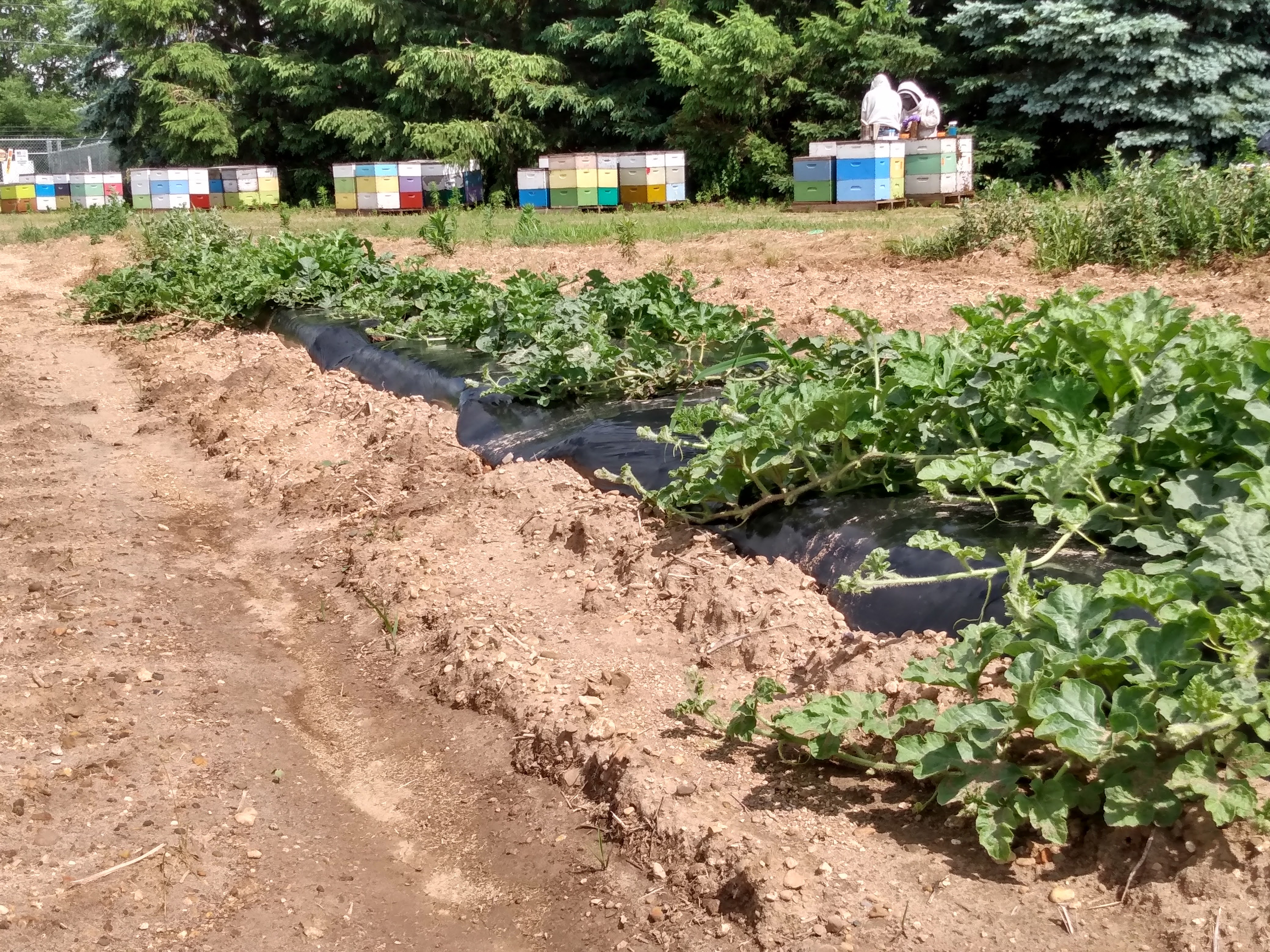
Honey bees from small-scale and sideline beekeepers:
Michigan is home to thousands of smaller beekeeping operations that maintain their colonies in Michigan throughout the year. Some small-scale beekeepers derive income by selling bees, honey, or other hive products, while others keep bees as a hobby. A number of these operations will consider small pollination contracts. The Michigan Beekeeper’s Association is the state-wide beekeeping organization for beekeepers of all operation sizes, and it maintains a map of local and regional beekeeping associations. Growers can reach out to local beekeeping clubs to ask if beekeepers are interested in providing pollination services. Beekeepers are often looking for new bee yards, and they may consider farms as a permanent bee yard, especially if the area provides good forage and the farm considers ways to reduce pesticide poisoning to bees. These arrangements are typically informal in nature but do provide an opportunity for mutual benefit if parameters and expectations are clear to both parties.
Getting your own honey bees:
Growing challenges to honey bee health in the past couple of decades have led to many beekeepers struggling to keep colonies alive. Beekeeping in Michigan has a steep learning curve, and beekeepers often lose their colonies if they do not invest a great deal of time learning about honey bee biology, colony management, managing parasites and disease, and nutrition. It is common for new beekeepers to lose most or all of their colonies when starting out. Growers considering getting their own bees should carefully evaluate the financial cost, time commitment, and physical efforts required to keep honey bees alive and healthy. Michigan State University’s Apiculture Extension Team recommends that all new beekeepers work with an experienced beekeeper before purchasing bees, take beekeeping classes, read books on honey bee biology, and consult trusted beekeeping resources.
Expectations and contracts with your beekeeper
Many agreements between growers and beekeepers are made without contracts, but growers may consider using a contract to set clear expectations and improve communication. Examples of sample contracts can be found online from MSU Michigan Pollinator Initiative.
Growers interested in inspecting colonies should talk to the beekeeper when they form a contract or arrangement. Beekeepers can open hives so the grower can see colony strength, and strength is measured in frames covered with bees. Inspections should be conducted soon after the hives are delivered for pollination. When colonies are inspected toward the end of their time in pollination, it is difficult to tell whether weak colonies were weak to begin with or if they became weak during their time in pollination.
When bloom is finished, growers should let the beekeeper know that the bees can moved out.
Protecting beekeepers from pesticide exposure
Growers should also be concerned that beekeepers may be exposed to pesticides. Beekeepers may not have received training related to pesticide exposure. If you are planning on applying a pesticide during the window of time when beekeepers might visit their colonies, please inform your beekeepers, and let them know when the re-entry interval will expire.
Placement of hives
Remember that you will get the most value out of a honey bee colony that is strong and has many foragers, so the more you can protect the hive, the better pollination services you’ll receive. Honey bees fly 2 miles or more for food, and a colony’s range can span over 8,000 acres. It is not necessary to place honey bee hives in the middle of vegetable fields to get pollination. Hives placed on the outsides of fields or behind buffers of wooded areas will have less direct exposure to pesticides, which may be beneficial to maintaining the strength of the honey bees and to the health of the beekeepers.
Beekeepers often move hives at night when bees are not foraging. If hives are moved during the day while bees are foraging, the bees outside of the hive will likely be lost, which can lead to colony stress and reduced colony strength. Read more about maximizing honey bee pollination in pickling cucumbers.
If you do need to move hives, they should be moved at least a couple of miles from the original location. If they are moved less than a few miles, the landscape will be familiar, and foraging bees can return to the previous hive location and become lost.
Beekeeper access to the bee yard is important to consider, and you want to make sure the bees can be moved in and out as quickly as possible. Choose locations that are not likely to become muddy. Muddy areas force the beekeeper to delay moving hives after pollination, which can in turn lead to a delay in certain insecticide applications. Find locations where the bees can be left in larger groups or drops. Larger groups of bees means faster loading and unloading, and more efficient pollination. Talk to your beekeeper to make sure they can easily access the hive drop sites.
Understanding honey bee biology and the risks of pesticides
It’s helpful for growers to understand honey bee biology in order to protect their investment in pollination services. A colony is a superorganism, meaning that all the bees living in a hive are considered to be an organism instead of each bee on the individual level. The queen bee lays eggs that develop into queens, drones, or workers. Queens are typically raised if a colony is preparing to swarm, the colony is replacing their current queen, or if the colony is suddenly queenless. There is usually just one queen in a colony. Most of the bees in the colony are worker bees (non-fertile females). The worker bees take on different roles as they age. Younger workers clean cells, feed the queen, draw wax comb, and feed developing bee larvae, while older worker bees forage for pollen, nectar, tree resins, and water to bring back to the hive. Younger bees and developing brood depend on the nectar and pollen that the foraging bees bring back to the hive. Male bees, or drones, try to mate with young queens from other colonies. They make up about 5-20% of the colony in the spring through fall, and the workers kick the drones out before winter.
When crops need pollination, growers need strong colonies with many older, foraging bees. These foraging bees provide pollination services when they visit flowers for pollen and nectar. It is important to know that it takes about 4-6 weeks from the time an egg is laid until a bee goes out to forage. If the colony loses a lot of bees (e.g. to pesticide damage or disease), then the forager force will be diminished, and you will not have good pollination. When foraging bees die outside of the hive, younger worker bees will take on foraging at a younger age. This transition causes stress on the colony and shortened lifespans. Similarly, when brood or young bees die unexpectedly, older bees may revert to conducting in-hive tasks instead of foraging. So, preventing bee loss protects the function of the colony.
It is important to talk with neighboring growers about managed bees and pesticide exposure. Honey bees forage 2 miles or more for food, and they can come into contact with pesticides applied by other growers. You may want to let nearby growers know when managed bees are in the area for pollination to discourage pesticide applications that may harm bees. Even if you are reading the label to make sure you are not spraying damaging insecticides while your bees are on site, your neighbor will likely not be taking your bees into consideration. To protect your investment in pollination services, consider all the bees can be exposed to while they are on your crop.
Other ways to help bees
Plant for bees
One of the best ways to help bees is to plant flowering trees, shrubs, and wildflowers. Good nutrition from a wide range of flowers throughout the growing season can help bees better deal with pesticide exposure, parasites, and diseases. As people who own or manage large areas of land, growers are in a unique position to provide large areas of quality habitat for bees. Creating and maintaining areas of natural habitat takes work, but it may also attract wild bee species and other beneficial insects to your farm. Growers can find resources about installing pollinator habitat from MSU’s Pollinator Initiative. Most vegetable fields have an area that should not be planted in crops due to water drainage or other problems. These areas may be considered for planting bee forage. Increasing forage to your farm may attract wild bees like squash bees and other beneficial insects.
Other helpful resources include Should producers chase after yield? by Ronald Goldy and Jonathan LaPorte and Tillage and squash bees: Protect your best source for pollination in your squash fields by Zsofia Szendrei.
Consider Wild and Native Bees
While this guide focuses on managed pollinators, like honey bees kept by beekeepers and bumble bee colonies purchased for pollination, wild and native bee species are important for pollination and to maintain a healthy ecosystem. You can learn more about wild bee species from Michigan Pollinator Initiative’s page of resources on native bees.
Learn about pollinators and spread the word
Growers can help pollinators by learning more about them and spreading the word. One educational opportunity is Michigan State University’s free, online Pollinator Champions course. The course takes about 5-10 hours to complete, and it can be done at your own pace. The course covers pollination basics, pollinator diversity, pollinator health issues, and how to support and protect pollinators. After completing the free course, you may choose to pay $30 for a certificate and outreach materials. You might also consider encouraging school-aged children to learn about bees and how they relate to the natural environment.
Summary
Bees face many threats to their health including diseases, pests, lack of good forage, and exposure to pesticides. Vegetable growers depend on bees for pollination and already take steps to try to improve bee health. The stronger and healthier the bees are, the better pollination you will get. Growers have many opportunities to help bees by creating a pollinator stewardship plan for their farm, and this document provides guidance in the important steps to take to benefit bees, beekeepers, and vegetable production.
For more ideas on how vegetable growers can support pollinator health, please read Vegetable pesticide series: Should I use it during bloom? A pollinator protection guide for vegetable growers.
Process for forming this document
This Vegetable Pollinator Stewardship Guide was authored by Ana Heck from the Michigan State University Pollinator Initiative with input and consultation from growers, Extension Educators, and researchers. The guide is an outcome of Michigan’s Managed Pollinator Protection Plan.
Visit pollinators.msu.edu/programs/protection-plan for the most recent version of this guide.
Please email Ana Heck at heckanar@msu.edu to provide suggestions or feedback for this guide.
Funding
The Michigan Department of Agriculture and Rural Development secured partial funding for an employee at MSU’s Michigan Pollinator Initiative to take the lead on ensuring that we are working on action items in Michigan’s Managed Pollinator Protection Plan. The Michigan Vegetable Council made a generous donation to support this guide.
Acknowledgments
Thank you to the Michigan Vegetable Council and to the following individuals who contributed to this guide: Norman Adams, Greg Bird, Stephanie Kipp, George McManus III, and Meghan Milbrath. This pollinator stewardship guide builds on information in the Vegetable pesticide series: Should I use it during bloom? A pollinator protection guide for vegetable growers by Ben Phillips and Marissa Schuh of Michigan State University Extension (2018). In addition, thank you to those who contributed to the Blueberry Pollinator Stewardship Guide which provided some of the initial content and direction for this guide.
References
[i] Phillips, B., and Schuh, M. (2018). “Vegetable pesticide series: Should I use it during bloom? A pollinator protection guide for vegetable growers.“ Michigan State University Extension.
[ii] vanEngelsdorp, D., Evans, J. D., Donvall, L., Mullen, C., Frazier, M., Frazier, J., Tarpy, D. R., Hayes, J. Jr., and Pettis, J.S. (2009). “'Entombed Pollen': A new condition in honey bee colonies associated with increased risk of colony mortality.“ Elselvier.



 Print
Print Email
Email

